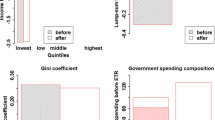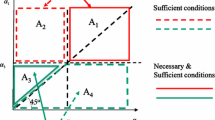Abstract
This paper examines the complications posed by pre-existing tax distortions in the economy, for the evaluation of a variety of subsidy policies that affect the environment. These complications include not only the efficiency cost of financing the subsidy by distortionary taxation, but also the interaction effects between the subsidized market and markets with pre-existing taxes. Studies that ignore both of these effects, or only incorporate the first type of effect, can be highly misleading.
Similar content being viewed by others
References
Alston, J. M., and B. H. Hurd. (1990). “Some Neglected Social Costs of Government Spending in Farm Programs.” American Journal of Agricultural Economics 72, 149–156.
Atkinson, A. B., and N. H. Stern. (1974). “Pigou, Taxation and Public Goods.” Review of Economic Studies 41, 119–128.
Ballard, C. L., and D. Fullerton. (1992). “Distortionary Taxes and the Provision of Public Goods.” Journal of Economic Perspectives 6, 117–131.
Ballard, C. L., and S. G. Medema. (1993). “The Marginal Efficiency Effects of Taxes and Subsidies in the Presence of Externalities.” Journal of Public Economics 52, 199–216.
Ballard, C. L., J. B. Shoven and J. Whalley. (1985). “General Equilibrium Computations of the Marginal Welfare Costs of Taxes in the United States.” American Economic Review 75, 128–138.
Baumol, W. J., and W. E. Oates. (1988). The Theory of Environmental Policy (Second edition). Cambridge, UK: Cambridge University Press.
Bovenberg, A. L., and R. A. de Mooij. (1994). “Environmental Levies and Distortionary Taxation.” American Economic Review 84, 1085–1089.
Bovenberg, A. L., and F. van der Ploeg. (1994). “Environmental Policy, Public Finance and the Labor Market in a Second Best World.” Journal of Public Economics 55, 349–390.
Bovenberg, A. L., and L. H. Goulder. (1996). “Optimal Environmental Taxation in the Presence of other Taxes: An Applied General Equilibrium Analysis.” American Economic Review 86, 985–1000.
Bovenberg, A. L., and L. H. Goulder. (1997). “Costs of Environmentally Motivated Taxes in the Presence of other Taxes: General Equilibrium Analysis.” National Tax Journal 50, 59–88.
Browning, E. K. (1987). “On the Marginal Welfare Cost of Taxation.” American Economic Review 77, 11–23.
Browning, E. K. (1992). “Subsidies Financed with Distorting Taxes.” National Tax Journal 45, 121–134.
CBO. (1996). “Labor Supply and Taxes.” Congressional Budget Office Memorandum, Washington, DC.
Fullerton, D. (1996). “Environmental Levies and Distortionary Taxation: Comment.” American Economic Review 87, 245–251.
Fullerton, D., and G. Metcalf (1996). “Environmental Controls, Scarcity Rents and Pre−Existing Distortions.” University of Texas, Austin, TX.
Goulder, L. H. (1995). “Effects of Carbon Taxes in an Economy with prior Tax Distortions: An Intertemporal General Equilibrium Analysis.” Journal of Environmental Economics and Management 29, 271–297.
Goulder, L. H., I. W. H. Parry and D. Burtraw. (1997). “Revenue−Raising vs. Other Approaches to Environmental Protection: The Critical Significance of Pre−Existing Tax Distortions.” RAND Journal of Economics 28, 708–731.
Gupta, S., K. Miranda and I. W. H. Parry. (1995). “Public Expenditure Policy and the Environment: A Review and Synthesis.” World Development 23, 515–528.
Harberger, A. C. (1984). “Basic Needs versus Distributional Weights in Social Cost−Benefit Analysis.” Economic Development and Cultural Change 32, 455–474.
Larsen, B. J., and A. Shah. (1992). “World Fossil Fuel Subsidies and Global Carbon Emissions.” World Bank, Washington, DC.
Ng, Y. K. (1980). “Optimal Corrective Taxes or Subsidies when Revenue−Raising Imposes an Excess Burden.” American Economic Review 70, 744–751.
Parry, I. W. H. (1995). “Pollution Taxes and Revenue Recycling.” Journal of Environmental Economics & Management 29, S64–S77.
Parry, I. W. H. (1997). “Environmental Taxes and Quotas in the Presence of Distortionary Taxes in Factor Markets.” Resource and Energy Economics 19, 203–220.
Piacentino, D., and S. Smith. (1994). “Taxes and Subsidies in Environmental Fiscal Reform.” Institute for Fiscal Studies, London, U. K.
Repetto, R., (1986). Skimming the Water: Rent−Seeking and the Performance of Public Irrigation Systems. World Resources Institute, Washington, D. C.
Repetto, R. (1988). The Forest for the Trees? Government Policy and the Misuse of Forest Resources. World Resources Institute, Washington, D. C.
Sandmo, A. (1975). “Optimal Taxation in the Presence of Externalities.” Swedish Journal of Economics 77, 86–98.
Schöb, R. (1996). “Environmental Levies and Distortionary Taxation: The Normalization Trap.” University of Munich, Munich, Germany.
Wildasin, D. E. (1984). “On Public Good Provision with Distortionary Taxation.” Economic Inquiry 22, 557–543.
Author information
Authors and Affiliations
Rights and permissions
About this article
Cite this article
Parry, I.W.H. A Second-Best Analysis of Environmental Subsidies. International Tax and Public Finance 5, 153–170 (1998). https://doi.org/10.1023/A:1008638320593
Issue Date:
DOI: https://doi.org/10.1023/A:1008638320593




